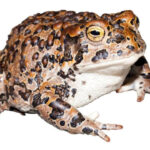The Secretive Life of Ischnocnema octavioi: Brazil’s Hidden Forest Jewel#
Deep within the lush forests and hidden streams of Brazil’s Atlantic rainforest lies a creature both delicate and remarkable. Silent and cryptically hidden among leaf litter and shadow-dappled ground, the Brazilian frog known as Ischnocnema octavioi has captivated researchers and nature lovers alike. Despite its modest size and shy disposition, this fascinating amphibian plays an extraordinary role not only within its ecosystem but also as an indicator for broader environmental health. Step silently into the hushed, humming forest, where moisture-soaked moss carpets the earth, and discover the hidden world of Ischnocnema octavioi.
Taxonomy and Classification#
Ischnocnema octavioi belongs to the family Brachycephalidae, within the genus Ischnocnema, a lineage of small terrestrial frogs known for their direct reproductive habits. Classified relatively recently, this amphibian species highlights the extraordinary diversity of Brazilian fauna, particularly within the rapidly diminishing Atlantic rainforest biome.
Much of the intrigue around Ischnocnema octavioi lies in its unique phylogenetic placement. Closely related species, such as Ischnocnema henselii and Ischnocnema guentheri, share overlapping habitats, yet subtle differences in behavior, morphology, and genetic constitution underscore the biodiversity hidden within these lush forests. Understanding the taxonomy of frogs like Ischnocnema octavioi is critical not just for herpetologists but also for conservationists aiming to protect these often overlooked amphibians.
Natural Habitat#
Nestled amid Brazil’s southeastern Atlantic rainforests—in states such as Rio de Janeiro and São Paulo—Ischnocnema octavioi thrives in ecosystems filled with dense vegetation, humid microclimates, and abundant leaf litter. The species depends heavily on the protection and moisture offered by fallen leaves, logs, and decomposing organic material on the forest floor, which harbor abundant insect prey and provide refuge from predators and harsh climatic conditions.
These cryptic frogs prefer elevations between 500 and 900 meters above sea level, where thick fog regularly envelopes the forest, enhancing humidity and creating perfect conditions for survival. In these misty, verdant landscapes, each decomposing log or rock cavity may conceal one of these elusive frogs, stealthily contributing to the balance and complexity of the ecosystem.
When walking quietly on damp trails, an attentive observer can sometimes glimpse one of these frogs momentarily revealed before it silently leaps away into the mosaic of greens and browns. Their preference for pristine habitats makes them sensitive barometers of environmental integrity, reflecting changes brought by natural events or human impacts.
Physical Characteristics#
Ischnocnema octavioi immediately charms its observers with its delicate and diminutive appearance, typically measuring no more than 20 millimeters in adult length. Its small stature, however, belies a remarkable resilience and adaptability suited specifically for life amid tree roots and leaf litter.
The coloration of Ischnocnema octavioi notably mirrors the subtle hues of its habitat—earthy shades of brown, gray, and olive green intermingle with spotted or striped patterning on their backs. This cryptic feature provides invaluable camouflage against the watchful eyes of predators—especially birds, snakes, and heaving ground beetles—and aiding the frogs in their own predatory pursuits, discretely ambushing small insects and arthropods hiding among leaf litter.
A particularly intriguing anatomical adaptation can be seen in their finger and toe pads, possessing specialized adhesive discs that ensure secure footing on damp, slick foliage and allowing precise movement along vertical and uneven surfaces. These modest yet vital adaptations underline nature’s efficiency, allowing these tiny, delicate creatures to overcome profound ecological hurdles.
Behavior and Life Cycle#
The secretive nature of Ischnocnema octavioi has made detailed behavioral studies relatively challenging, yet this elusive quality itself paints a picture of an amphibian that has perfected the subtle art of survival. Primarily nocturnal, individuals spend daylight hours concealed beneath leaves, moss, and logs, emerging after sunset to forage obsessively upon the forest floor in pursuit of a diverse selection of insects, spiders, mites, and small invertebrates.
Unique among many amphibians, Ischnocnema octavioi exhibits direct development—a fascinating reproductive strategy in which fully formed miniature frogs emerge directly from terrestrial eggs, entirely skipping an aquatic tadpole stage. Females deposit a small clutch of delicate eggs into moist pockets within leaf litter, rotting wood, or moss-covered rocks, guarding their precious cargo from both desiccation and predation.
Such parental care, although minimal compared to species with more direct involvement, demonstrates a profound evolutionary adaptation allowing Ischnocnema octavioi to flourish even in relatively ephemeral or isolated habitats. This reproduction strategy allows it to colonize parts of the forest that traditional aquatic-dependent amphibians simply could not thrive in.
Ecological Role#
Though small and shy, aspiring unnoticed amid bewildering biodiversity, Ischnocnema octavioi plays a powerful ecological part within its environment. One could easily overlook the frog’s significant role as both predator and prey. It actively regulates forest floor insect populations, helping maintain ecological equilibrium—a subtle yet significant service to the broader health of the forest system.
Moreover, Ischnocnema octavioi contributes directly as prey to a variety of terrestrial predators—snakes, lizards, birds, and small mammals all benefit from these abundant yet elusive miniature amphibians. Through these interconnected relationships, the species embodies the intrinsic connectedness and fragility of rainforest ecosystems, teaching us much about ecological balance and resilience.
Threats and Conservation Status#
Unfortunately, like many species endemic to Brazil’s Atlantic rainforest, Ischnocnema octavioi faces significant threats. Rampant habitat destruction from deforestation, agriculture expansion, urbanization, and logging pose grave concerns, threatening not just these frogs but an entire interconnected web of biodiversity.
Increasingly evident climate fluctuations, resulting in altered rainfall patterns, temperature extremes, and changing moisture regimes, further pressure these sensitive animals. Habitat fragmentation exacerbates these challenges, isolating populations and limiting genetic diversity, potentially paving the path to local extinctions.
Classified currently as “Data Deficient” by the International Union for Conservation of Nature (IUCN), Ischnocnema octavioi urgently requires more robust conservation assessments and measures, beginning with preserving its rainforest home. Raising awareness, protecting remnants of habitat, and increasing scientific research efforts remain vital and immediate priorities if we hope to preserve this unique and intricate piece of Brazil’s amphibian heritage.
Cultural and Scientific Significance#
While Ischnocnema octavioi might not hold the widespread cultural symbolism reserved for charismatic fauna, these small frogs represent the immense hidden biodiversity of the Atlantic rainforest. For traditional and indigenous communities inhabiting the region, creatures such as this frog may symbolize nature’s quiet wisdom, intimately intertwined with ecological health and well-being.
Scientifically, studying its physiological adaptations, reproduction strategies, and ecological resilience offers invaluable insights into evolutionary biology, climate change adaptation, conservation perspectives, and habitat preservation strategies. Each discovery about Ischnocnema octavioi advances our understanding of amphibian biology, population genetics, and ecological interactions necessary to sustain healthy ecosystems globally.
Conclusion#
Protected beneath layers of rainforest mist, under glistening emerald canopies, the delicate and secretive Ischnocnema octavioi embodies the beauty, complexity, and fragility of Brazil’s precious Atlantic forest ecosystems. By appreciating and understanding these small amphibians, we embrace a broader commitment—to protecting biodiversity, respecting ecological interconnectedness, and safeguarding our shared environmental heritage.
Let the quiet yet marvelous story of Ischnocnema octavioi inspire us all to explore further, tread lightly in nature, and champion effective, timely conservation efforts so future generations may continue discovering the wonders hidden within the leaf litter, forever more.







